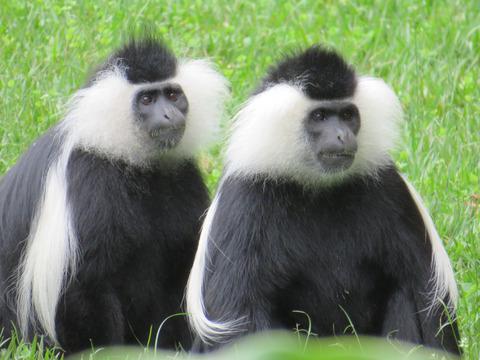当前位置:
X-MOL 学术
›
Anim. Conserv.
›
论文详情
Our official English website, www.x-mol.net, welcomes your
feedback! (Note: you will need to create a separate account there.)
Comparison of species richness and detection between line transects, ground camera traps, and arboreal camera traps
Animal Conservation ( IF 2.8 ) Pub Date : 2020-03-05 , DOI: 10.1111/acv.12569 J. F. Moore 1 , W. E. Pine 2 , F. Mulindahabi 3 , P. Niyigaba 3 , G. Gatorano 3 , M. K. Masozera 4 , L. Beaudrot 1
Animal Conservation ( IF 2.8 ) Pub Date : 2020-03-05 , DOI: 10.1111/acv.12569 J. F. Moore 1 , W. E. Pine 2 , F. Mulindahabi 3 , P. Niyigaba 3 , G. Gatorano 3 , M. K. Masozera 4 , L. Beaudrot 1
Affiliation

|
Monitoring trends in the occurrence of species over time is important for informing conservation plans and concurrent management actions. Understanding the effectiveness of field methodologies for collecting accurate and precise data is crucial for optimizing allocation of sampling effort and resources. In this study, we compared mammalian species richness and detection probabilities between three field methodologies: line transects, ground camera traps and arboreal camera traps in Nyungwe National Park, Rwanda. Arboreal camera traps may be suitable for monitoring mammal communities with arboreal species, but their relative effectiveness compared to the more common field methods, line transects and ground camera traps, is relatively unknown. Using single‐season occupancy models with multi‐species data and single‐species multi‐method occupancy models, we estimated mammalian species richness and detection probability for each method and combination of methods. In addition, we estimated single‐species occupancy and detection probability by method for six diurnal primate species. And, we tested for the effect of height on a tree on estimated occupancy probability and detection probability for arboreal camera traps. Overall, for all species the combination of ground and arboreal cameras was the most effective methodology in terms of highest estimates of occupancy and detection coupled with highest precision. However, for the six primate species the most effective method differed between species. The height of the arboreal camera trap in the tree did not significantly affect estimates of occupancy or detection. We suggest using all three field methods concurrently to maximize detection of all species; however, if only two methods can be deployed combining arboreal and ground cameras provided the highest and most precise estimates of occupancy and detection. The addition of arboreal camera traps could improve detection of species and improve future species monitoring programs.
中文翻译:

线样线,地面相机陷阱和树木相机陷阱之间物种丰富度和检测的比较
监视物种随时间变化的趋势对于告知保护计划和同时进行的管理行动很重要。了解现场方法学收集准确和精确数据的有效性对于优化采样工作和资源分配至关重要。在这项研究中,我们比较了卢旺达Nyungwe国家公园三种线野方法之间的哺乳动物物种丰富度和检测概率:线样线,地面相机陷阱和树木相机陷阱。树木相机诱捕器可能适用于监测具有树木物种的哺乳动物群落,但是与更常见的野外方法,线样线和地面相机诱捕器相比,它们的相对有效性尚不清楚。使用具有多物种数据的单季节占用模型和单物种多方法占用模型,我们估计了每种方法和方法组合的哺乳动物物种丰富度和检测概率。此外,我们通过方法估算了六个昼夜灵长类物种的单物种占有率和检测概率。并且,我们测试了树上的高度对树木相机陷阱的估计占用率和检测概率的影响。总体而言,就占用率和探测的最高估计以及最高精度而言,地面摄像机和树木摄像机的组合是最有效的方法。但是,对于六个灵长类动物而言,最有效的方法因物种而异。树上的树状照相机陷阱的高度并未显着影响占用或检测的估计。我们建议同时使用所有三种田间方法以最大程度地检测所有物种。但是,如果只能采用两种方法结合使用树木和地面摄像机,则可以提供最高和最精确的占用率和探测率估计。增加树栖相机陷阱可以改善物种检测并改善未来的物种监测程序。
更新日期:2020-03-05
中文翻译:

线样线,地面相机陷阱和树木相机陷阱之间物种丰富度和检测的比较
监视物种随时间变化的趋势对于告知保护计划和同时进行的管理行动很重要。了解现场方法学收集准确和精确数据的有效性对于优化采样工作和资源分配至关重要。在这项研究中,我们比较了卢旺达Nyungwe国家公园三种线野方法之间的哺乳动物物种丰富度和检测概率:线样线,地面相机陷阱和树木相机陷阱。树木相机诱捕器可能适用于监测具有树木物种的哺乳动物群落,但是与更常见的野外方法,线样线和地面相机诱捕器相比,它们的相对有效性尚不清楚。使用具有多物种数据的单季节占用模型和单物种多方法占用模型,我们估计了每种方法和方法组合的哺乳动物物种丰富度和检测概率。此外,我们通过方法估算了六个昼夜灵长类物种的单物种占有率和检测概率。并且,我们测试了树上的高度对树木相机陷阱的估计占用率和检测概率的影响。总体而言,就占用率和探测的最高估计以及最高精度而言,地面摄像机和树木摄像机的组合是最有效的方法。但是,对于六个灵长类动物而言,最有效的方法因物种而异。树上的树状照相机陷阱的高度并未显着影响占用或检测的估计。我们建议同时使用所有三种田间方法以最大程度地检测所有物种。但是,如果只能采用两种方法结合使用树木和地面摄像机,则可以提供最高和最精确的占用率和探测率估计。增加树栖相机陷阱可以改善物种检测并改善未来的物种监测程序。











































 京公网安备 11010802027423号
京公网安备 11010802027423号